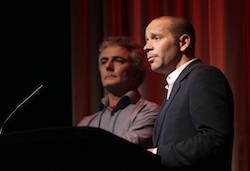
IT Broadcast Workflow 2011: Why ITV outsourced; the smooth transition to Red Bee; and tapping into additional expertise.
ITV’s Content Store allows the UK broadcaster to store, enhance and deliver its content to a variety of platforms, and has been implemented on an outsourced model by Red Bee Media.
It was initially set up about four years ago, and ITV worked with another vendor until mid-2009, when that vendor decided to leave the market. “We had to find another supplier very quickly,” explained Luan Thompson, ITV’s programme manager, Technology & Platforms.
The Store enables file-based workflows and delivery to video on demand and catch-up services. It takes in material from ITV Studios and independent producers, and interacts with ITV’s planning and scheduling systems, its internal workflow, and its media management. Red Bee takes tapes in, digitises them, performs various tasks, such as metadata processing and timecode capture, “which are the key to automating the other processes”. It then processes the content into a variety of formats, processes metadata into customer-specific formats, and distributes the content to partners (such as itv.com, ITV Broadcast, iTunes, Amazon and BT Vision).
ITV selected Red Bee in November 2009, leaving weeks to deliver initial services and start migrating the content from the previous vendor. “We needed to work in an agile way. With eight weeks we didn’t have time to write any complex specifications for what was required,” explained Chris Wood, principal software architect at Red Bee Media.
“We just needed to have a basic understanding of what was needed as an initial roll out and leave the details of the future services to ‘just in time’. ITV wanted to outsource the processes that we managed as a service, although they also wanted to retain overall control of the high-level workflow from the acquisition to the fulfilment of their content.”
ITV wanted Red Bee to be “a loosely coupled cog” in the machine, “where it would be possible for them to modify the services that were required, and if necessary potentially move to a different vendor with minimal pain. Obviously that’s a driver for us to perform extremely well as well,” he added. Red Bee also had to avoid lock-in with its third-party vendors. The implementation needed to keep metadata to a minimum, and to avoid heavyweight integration or synchronisation of databases between the two companies.
The service was running on time, on 1 January, 2010. “Was it completely seamless and everything completely automated? No it wasn’t. But, the most important thing was perhaps Red Bee’s attitude towards it, that whatever it took ‘We will get that content delivered for you’,” said Thompson. The fully integrated workflows were online within weeks, initially for VoD, its first priority. “Overall, it was hard work, particularly around getting a lot of the content migrated and making sure that was prioritised, so we had the right content at Red Bee to do the fulfilment. But overall, looking back at it, I think that was a pretty good success.”
Wood sees workflow as more than just a chain of activities. “You need to think about four dimensions all at the same time.” Besides the linear business process of A, then B, then C or D, arbitrary things happen at the same time. “So you have to be able to react to things like file arrivals at random times, long-running processes finishing at unexpected times, and general exceptions happening within the system as well.”
There are also aspects like archive that need to be run at regular intervals and based on business rules. “There are also humans interacting with the content store as well. Increasingly, our customers are expecting to be able to interact with their content, to be able to upload assets themselves and to request in random and interactive ways, activities and processes to be executed on their content.”
To achieve this flexibility it has, underlying its design, SOA (service oriented architecture). This organises the technology around the key business functions required, and then extracts the delivery of those functions from any vendor, exposing them through common interfaces. In broadcasting, such services would include transcoding, asset management, delivery, or quality control.
“In a proper service oriented architecture each of those services is unique and independent and doesn’t rely on any of the other services to run. What that enables you to do is organise those services in flexible and agile ways using business process management systems (BPMS),” said Wood.
One of Red Bee’s previous major projects was with Channel 4, which outsourced its playout and media management. “During that project we procured a BPMS platform, called Cordis, but many software vendors provide these, and what that allows us to do is to graphically design workflows and orchestrate these SOA services in agile and flexible ways.” This allows it to get a better return on investment on IT through maximised reuse and generally reduce the IT burden. BPMS has reduced support costs and also makes it easier to pull out an existing process and change it.
Hardly any of the platform it used for ITV was custom built, apart from the workflows themselves and some of the interfaces that it enhanced. Red Bee has its own in-house material management system for managing tape delivery. It uses Agility and Rhozet for transcoding, Ardome for asset management (among others it has), and Signiant for file acceleration, but the Content Store project doesn’t integrate directly with these. There is a services layer, which abstracts all of the proprietary interfaces and enables the BPMS layer to call the services without having to know the details of the exact vendor interactions. It also makes it simpler to monitor activity, and trigger different processes if a threshold is reached or service level agreements are about to be breached. Management reporting is also significantly easier.
It has also set up an Enterprise Service Bus for messages, which is common in the IT world, but just starting to be used within broadcasting. It complements the BPMS, and is like a network router for data, allowing the management of a large volume of messages, doing translations between one vendor’s format and another, and managing the complex routing between systems and reacting to system events. Red Bee uses it to manage file delivery and generate wake-up messages for each process that needs to be run. It decouples the business processes from the way that the media is being managed in the background; to keep the business processes simple and visible.
Standards are also important, for interoperability between systems, such as BXF for managing interoperability of context of metadata. The Broadcast eXchange Format. (SMPTE S2021-x-2009) is a schema based on file-based workflow. Red Bee first used it with Snell and Ardendo systems for staging content for transmission for Channel 4, based around XML file integration. For ITV, when it was developing the IP web service integration, “we wanted to adopt some standards that were extensible but would also enable us to short cut the design process in terms of feeding metadata back to them,” explained Wood.
To do this it created some abstract services on top of its MAM system to allow ITV to come in with web service calls in the background to query the database, which then returns BXF. “It wasn’t the way that BXF was primarily designed to be used. It’s really based on file-based workflow, so a single file can be a message of any sort, which doesn’t really fit with a more operations-based series of services that are tied quite closely to the functions that are carried out. So, really the way that we got around that is that we used it mainly as a data schema, but we did find it very adaptable and extensible and we will continue to use it in the future.”
A future standard of interest is FIMS (Framework for Interoperable Media Service), which is being worked on by the EBU and AMWA. It is an initiative to standardise interoperability between web services in the media industries.
“It’s an admirable and important exercise. I think that standardisation is always a difficult one, because there’s a tension between vendors and service providers like us wanting to rapidly roll out new features and the benefits of standardised interoperability as well. As long as it can move very fast then it will be a very useful thing.” Red Bee is involved in the process, and aims to be at the forefront of implementing it. “But it probably needs to be seen as a clean up exercise.” Many vendors have already implemented services for transcode or are offering the API interoperability layer. “To retrofit all of that will be difficult to find a business case for,” said Wood.
However, he feels that even if vendors and broadcasters can get together to try to formulate a common vocabulary and a common understanding of what is required would be a valuable thing.
One of the questions asked at the end was why ITV outsourced. “It is certainly about saving costs,” replied Thompson. Besides, it didn’t have any time to build anything itself, so looked for someone with existing infrastructure, especially if that was shared with existing clients, who were also making use of such services as delivery to iTunes.
“There is a lot of commonality there that we would seek to benefit from, because we’re sharing the costs with their other clients. I think that also the level of expertise that we find with Red Bee we don’t have within ITV at present, and we would have needed quite some time to build that up.” – David Fox






